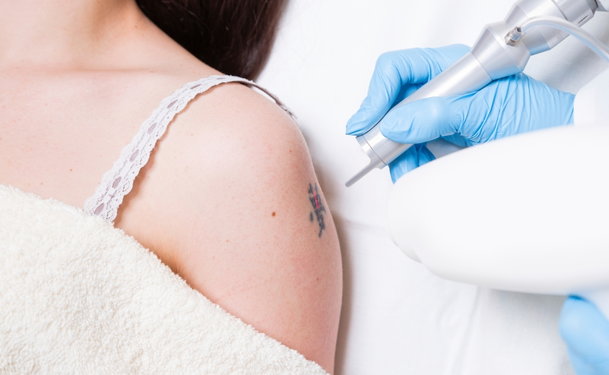Tattoos, as fun as they may be at the time you get them, are considered a permanent form of skin art. The operative word here is “permanent.” Sometimes you can change your mind about the “permanent” part and want that tattoo removed. What are your treatment choices and which treatments deliver the fastest results?
Treatment Choices & Results
At-home cream removal
While this is the least expensive option and is a do-it-yourself treatment, it is not a very effective choice for tattoo removal. You could spend many months applying expensive creams to your tattoo and see only minimal fading.
Camouflage
This process is a less used option but can sometimes effectively cover a tattoo. The tattoo is not actually removed, rather it is injected with skin-colored pigment to hide the image. While the intent is to match the skin tone, it is not always an exact match. This can make the treated skin appear flat or mottled. Injecting the tattooed skin with another pigment can be done in one visit or a series of visits, so the results are relatively fast, if not always 100 percent satisfactory.
Surgical excision
Surgical excision of a tattoo is usually reserved for only small sized tattoos. The process should start with a consult with a licensed physician, usually a dermatologist or general surgeon. The physician will first apply a chemical to the tattooed area. The chemical affects the skin sufficiently enough that some of the ink can be scratched off. This initial process is often followed by actually suturing the remaining edges of the tattooed skin together.
Surgical excision can be performed in one visit to the physician. While the tattoo is no longer visible, it is replaced by a linear scar. The scar will always be visible but the suture line redness will fade over time.
Dermabrasion
Dermabrasion works on all skin tones but can also permanently change the skin color of the treated area. Dermabrasion involves a sandpaper-like or abrasive treatment applied to the tattooed area. This option is used to "sand" away a tattoo. It removes the top layer of skin that holds the ink. This is often an effective choice but is painful and can leave a visible scar to the area. It can take more than one visit to complete the dermabrasion process.
Laser removal
Laser tattoo removal is the most popular method of tattoo removal. The process involves pulses of intense light, which are focused directly on the tattoo. The laser actually shatters the ink that is embedded in the skin into fragments. The shattered fragments dissipate and are slowly absorbed by the body’s natural immune system.
Q-Switched laser treatment is rapidly growing in popularity. Unlike many of the other tattoo-removal options, it does not usually cause scarring at the treated area. Depending upon the size and depth of the tattoo, multiple laser treatments are sometimes necessary, and this process can be drawn out over a period of months. The more the area is treated, the more likely it is that blistering and subsequent scarring can occur.
Intense pulsed light therapy
Intense pulsed light (IPL) therapy is the same concept and actual process as laser treatment but uses a different light source. IPL is reported to be somewhat less painful and more effective than traditional laser treatment.
The end result
What option should a patient choose as the best and fastest course of treatment for tattoo removal?
The most effective method of tattoo removal is clearly laser, whether traditional or intense (laser) pulsed light therapy. Even though laser treatments may be spaced out over several months, this is the method that delivers real results, so in the end the laser-removal timeline is the fastest.
If you have questions about any of these tattoo removal methods, consult with a specialist in your area.


